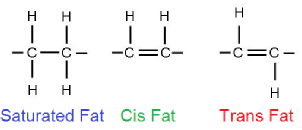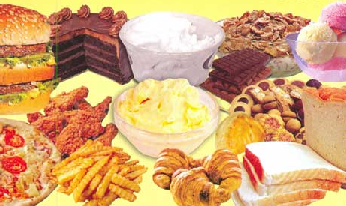
Know Facts
To Know Or Not To Know …




Facts About Trans Fat
Trans fat is fat with unsaturated fatty acids having at least one double binding
in trans  formation (se picture) as opposed to the cis formation in the essential
fatty acids like omega-
formation (se picture) as opposed to the cis formation in the essential
fatty acids like omega-
In food production trans fats occur during processing of polyunsaturated fatty acids by adding hydrogen through a process called hydrogenation, which makes the oils less likely to spoil.
Using trans fats in the manufacturing of foods helps foods stay fresh longer, have a longer shelf life and have a less greasy feel.
Trans Fats Are Not Good For Your Health
The consumption of trans fats may increase the risk of coronary heart disease by raising levels of “bad” LDL cholesterol and lowering levels of "good" HDL cholesterol.
Dietary trans fatty acids are more deleterious with respect to coronary heart disease than saturated fatty acids.
Nutritional authorities consider all trans fats as equally harmful for health and recommend that consumption of trans fats be reduced to trace amounts.
Sources
 Commercial baked goods — such as crackers, cookies and cakes — and many fried foods,
such as doughnuts and french fries — may contain trans fats. Shortenings and some
margarines can be high in trans fat. Here is a list of foods having the highest content
of trans fats.
Commercial baked goods — such as crackers, cookies and cakes — and many fried foods,
such as doughnuts and french fries — may contain trans fats. Shortenings and some
margarines can be high in trans fat. Here is a list of foods having the highest content
of trans fats.
Trans fat used to be more common, but in recent years food manufacturers have used it less because of concerns over the health effects of trans fat. Food manufacturers in the United States and many other countries list the trans fat content on nutrition labels.
In some countries (e.g. Denmark) laws effectively ban the use of trans fats.
How To Avoid Trans Fat
How do you know whether food contains trans fat? Look for the words "partially hydrogenated" vegetable oil in the nutritional labels. That's another term for trans fat.
"Fully" or "completely" hydrogenated oil doesn't contain trans fat but satuated fat, because all double bindings have been replaced by single bindings (see picture at the top).
If the label says just "hydrogenated" vegetable oil, it could mean the oil contains some trans fat.
Although small amounts of trans fat occur naturally in some meat and dairy products, it's the trans fats in processed foods that seem to be more harmful.
Copyright: Know Facts -
